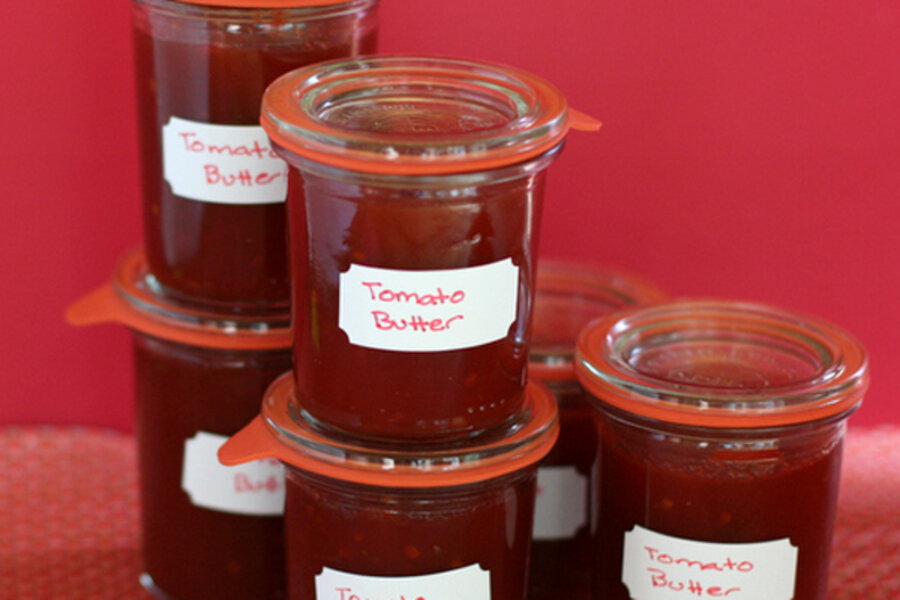Tomato butter
Loading...
I spend a great deal of time in the summer putting up gorgeous fresh tomatoes for winter. Almost as much time as I do eating them. Zip-top bags full of sauce and soup base. Salsa, bloody mary mix and chutney in jars. And this, my favorite tomato condiment.
I discovered recipes for tomato butter in several very old community cookbooks. The kind of recipes that call for a peck of tomatoes and sugar, just sugar no measurements. I was intrigued first by the name – I make lots of fruit butters, but had never thought about doing it with tomatoes. Then I was drawn in by the addition of vinegar; I could see how a hit of acid would really balance the sweetness of the tomatoes and sugar. So I set to work scaling this to a recipe more reasonable for my needs. And I love it.
Tomato butter has a jam like consistency and a deep, glossy, rich red color. It is sweet and tart, perfectly playing on all the attributes of a good tomato. Try this on a hamburger, and you may never go back to ketchup again. It is excellent dolloped on a steak or a piece of fish. It makes a wonderful mid-winter BLT and it is an elegant addition to a cheeseboard. My favorite usage is spread thick on good bread bought from a local baker, a few thick sliced of creamy brie and some smoky bacon, toasted, and pressed. And I warn you, once you start making this, it may become an addiction.
Tomato butter
Makes 3–4 1/2-pint jars, plus a little extra
5 pounds tomatoes, peeled
2 cups sugar
½ cup cider vinegar
1. First, place a small ceramic plate in the freezer. You’ll use this this to test the set of the jam later. Then get your jars clean. You will need 5-6 half-pint mason jars (I always have an extra on hand in case I need it). I clean the jars and the rings in the dishwasher, and leave them in there with the door closed to stay warm. You can’t put the lids in the dishwasher, it will ruin them.
2. Chop the tomatoes and place them in a large Dutch oven with the sugar and vinegar. Stir everything together, then turn the heat to medium and simmer until the tomatoes begin to break down and become soft, about 15 minutes. Blend the tomatoes with an immersion blender until you have a smooth puree. Lower the heat and continue simmering the jam, stirring frequently, until the liquid has reduced and the mixture is thick and spreadable. This could take anywhere from 40 minutes to over an hour, depending on how juicy your tomatoes are. As the mixture thickens, stir more often and watch carefully to prevent scorching.
3. When the jam has cooked down and is thickened, pull that little plate out of the freezer and spoon a little jam onto it. Leave to set for a minute, then tilt the plate. If the jam stays put, or only runs a little bit, it’s ready. Also, run a finger through the jam on the plate if the two sides stay separate and don’t run back together, you’re good to go.
4. While you jam is cooking, get a boiling water canner or big stockpot of water going. Here are step-by step instructions for processing jam in a canner. When the jam is almost ready, pour some boiling water over the jar lids jars to soften the seals and set aside.
5. When the jam has met the set test, remove it from the heat. I like to ladle the jam into a large measuring jug for easy pouring. Fill each of your warm, cleaned jars with the jam, leaving a 1/2-inch head space. Wipe the rimes of the jars with a damp paper towel to clean up any sticky spills. Dry the lids with a clean paper towel and place on the jars. Screw on the bands tightly, then process the jars for 15 minutes in a boiling water bath. If you have a bit of extra jam, scoop it into a refrigerator container and keep in the fridge for up to a week.
6. When the jars are processed, leave to cool on a towel on the counter.
7. The processed jars will keep for a year in a cool, dark place. Don’t forget to label your jars!
(I have also made this in the slow cooker. To do this, place all the ingredients in the cooker and cook uncovered for 12–14 hours until set. Puree the tomatoes when they are soft.)







